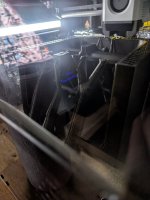So we're right around the 20 hour mark and between my new design and not in doing any filament changes everything is looking perfect. I expect the rest of the parts to go off without a hitch and take WAY less time to print than previously.
It's impossible to get a good photo through the small viewport.
It's impossible to get a good photo through the small viewport.
Attachments
The mixture I've run across is plaster of Paris mixed with white glue / yellow wood glue. Makes the plaster stronger and less brittle.Another builder said plaster of Paris ended up being his preferred filler inside the walls.
I suggest empty caulk tubes (Amazon) and a caulk gun for getting the mixture into the walls as well as a palm sander or other strong source of vibration to reduce air pockets and settle the filler.
@brandon3212276 Will you be posting the 3d print files here or to one of the STL / print file websites?
I would say that PVA glue needs something to absorb the moisture from it and if sealed up in a plastic gallery it would theoretically not set. This may then be part of the reason for the need to include the plaster.plaster of Paris mixed with white glue
Apart from that, PVA does have a tendency to damp which makes this a plausible option.
This design does not use hollow walls, I'm going to add a lot of damping to the inside of the cabinet though. My original design had hollow walls and I'll post it as well, it was much more difficult to print though. You can modify my STEP files any way you please though.
Once I get this successfully printed I'll post the files for anyone to use. I also have a 3D printed Amp Camp Amp enclosure that I'll post.
Once I get this successfully printed I'll post the files for anyone to use. I also have a 3D printed Amp Camp Amp enclosure that I'll post.
